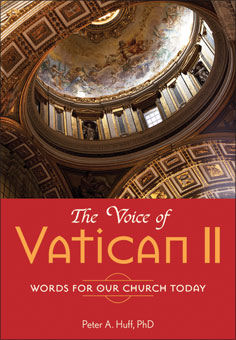
|
Posted April 19, 2006
Book: Living Vatican II: The 21st Council for the 21st Century Author: Gerald O’Collins, SJ Paulist Press, NY, 2006, pp. 243 An Excerpt from the Jacket:
As a leading theologian, the author uses a highly personal approach in answering these and many other questions, which makes for a compulsively readable book that illuminates the workings of the Church. Living Vatican II explores the liturgical renewal after Vatican II, the reception of the Council’s moral teaching, the impact of Vatican II, the reception of the Council’s moral teaching, the impact of Vatican II on theology, and the work of some key institutions in Rome and elsewhere toward implementing the teaching and decisions of this council. Finally, the book offers insightful suggestions about the future of the Church. An Excerpt from the Book: Other Dreams Let me mention three [dreams]. First, it seems pressingly important to have many more women assisting the pope by working in the Roman Curia in positions of real power and influence. Given the fact that women make up the majority of those who follow religious life, it seems extraordinary that only one nun enjoys a leadership role in the Congregation for Institutes of Consecrated Life and for Societies of Apostolic Life. Then, why not have a married woman heading the Pontifical Council for the Family? Or, for that matter, a married couple doing so? Likewise it would seem not only appropriate but also very helpful to have one or more women with an excellent background in health care leading the Pontifical Council for the Pastoral Care of the Health Care Apostolate. In a lecture given in London on December 18, 2003, Cherie Booth, the Catholic wife of the British prime minister, Tony Blair, remarked: “There is little reason why half of all Vatican curial positions could not be filled by women.” My second dream focuses on inculturation, the need to translate ways of expressing and living Christian faith into local thought patterns and traditions. Inculturation is much deeper than just music, drums, and clapping of hands, even though it can call for such liturgical adaptations. Here a dictum from the early centuries of the church that St. Thomas Aquinas endorsed enjoys its importance: “Every truth, no matter by whom it is said, comes form the Holy Spirit.” Since goodness and beauty belong necessarily with truth and since one cannot imagine the Holy Spirit inspiring truth but being unconcerned about goodness and beauty, one could legitimately expand the dictum and declare: “All truth, goodness, and beauty, no matter by whom they are expressed, come from the Holy Spirit.” In broader terms, wherever there is truth, goodness, and beauty in a culture, there is the Holy Spirit. Hence, the process of inculturation goes beyond familiarity with local terms and concepts and beyond a creativity in adapting religious and liturgical language to local settings. The process calls for a deep sensitivity to the powerful presence of the Spirit who develops everything that is true, good, and beautiful in a given culture. Such elements appear with a certain intensity on the occasion, for instance, of births, marriages, and deaths. In Gaudium et Spes, when dealing with “what the Church can receive from the world,” the bishops at Vatican II spoke of “the riches hidden in various cultures.” These are riches of truth, goodness, and beauty inspired by the Holy Spirit that, with the help of the same Spirit, can be discerned and appropriated. My dream of inculturation does not simply ask a human question: To what extent must Africans reject their culture(s) to become Catholics? My dream raises a question that St. Basil and the other Cappadocians would have liked: What does an openness to the work of the Holy Spirit in this culture lead us to discern and decide? In seventeenth-century China, Catholic missionaries showed a remarkable cultural openness that promised to convert the whole nation to the Christian faith. One of the great might-have-beens in world history came to a stop when the Vatican forbade religious services in Chinese, suppressed recent Bible translations, and reduced the Catholic Church to a small, persecuted body. One could name further dreams for the church: for instance, a reform in the selection of bishops, a greater representation of the local churches at the papal elections, and a more effective presence of Catholics and other Christians in the world of mass communications. But the third dream with which I want to conclude is a broad one, a dream Vatican II took over from Pope John XXIII, who expressed it in the words of St. Augustine: “Let there be unity in what is necessary, freedom in which is doubtful, and charity in everything. Sadly in some parts of the Western world we have to endure much polarization and distrust not only in the world but also within the church. I dream of a church and a world in which the Father, Son, and Holy Spirit will liberate the whole human family from all forms of fear and greed and draw them into the eternal mystery of love. Table of Contents: 1. How Vatican II change my church 2. Facilitators or gatekeepers? 3. Receiving a Council with creative fidelity 4. Liturgical progress 5. Receiving the Council’s moral teaching 6. Relations with others 7. Theology for the Church and the world 8. The coming church 9. Epilogue Appendixes: Some postconciliar texts |
|
